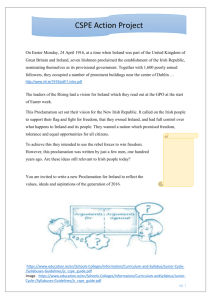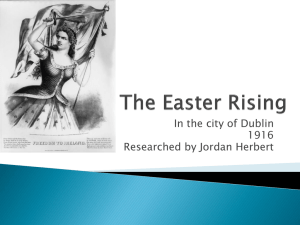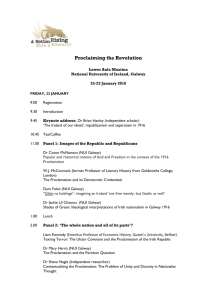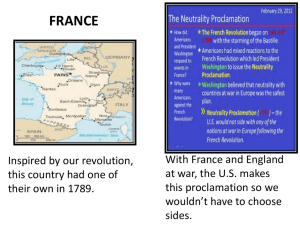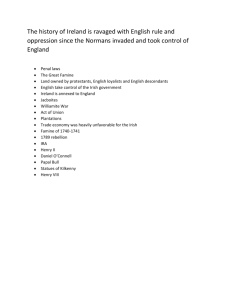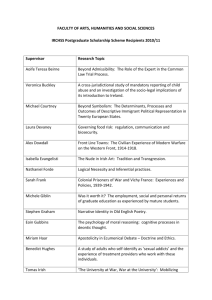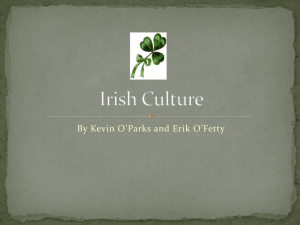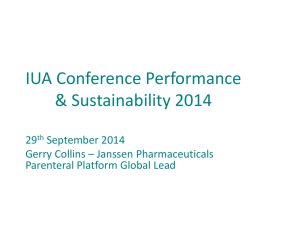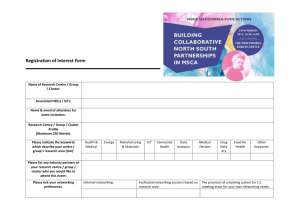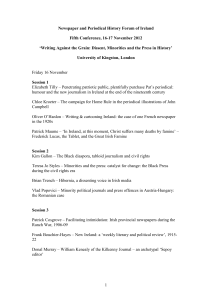Reimagining the Proclamation
advertisement
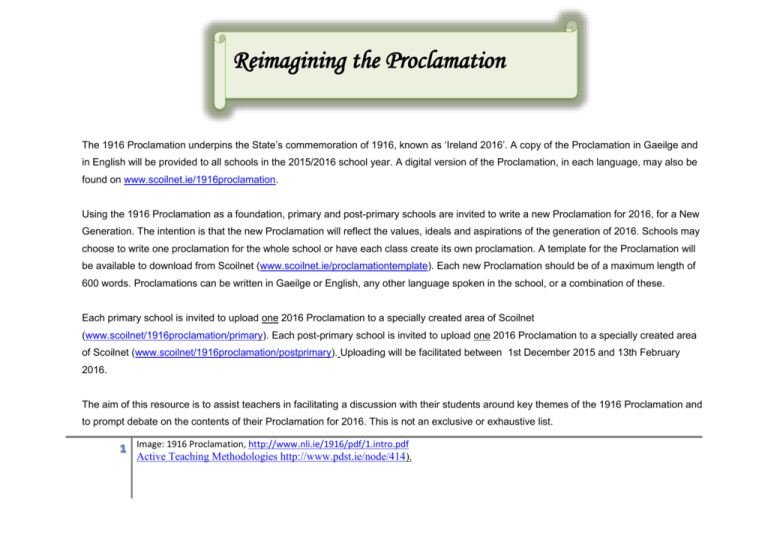
Reimagining the Proclamation The 1916 Proclamation underpins the State’s commemoration of 1916, known as ‘Ireland 2016’. A copy of the Proclamation in Gaeilge and in English will be provided to all schools in the 2015/2016 school year. A digital version of the Proclamation, in each language, may also be found on www.scoilnet.ie/1916proclamation. Using the 1916 Proclamation as a foundation, primary and post-primary schools are invited to write a new Proclamation for 2016, for a New Generation. The intention is that the new Proclamation will reflect the values, ideals and aspirations of the generation of 2016. Schools may choose to write one proclamation for the whole school or have each class create its own proclamation. A template for the Proclamation will be available to download from Scoilnet (www.scoilnet.ie/proclamationtemplate). Each new Proclamation should be of a maximum length of 600 words. Proclamations can be written in Gaeilge or English, any other language spoken in the school, or a combination of these. Each primary school is invited to upload one 2016 Proclamation to a specially created area of Scoilnet (www.scoilnet/1916proclamation/primary). Each post-primary school is invited to upload one 2016 Proclamation to a specially created area of Scoilnet (www.scoilnet/1916proclamation/postprimary). Uploading will be facilitated between 1st December 2015 and 13th February 2016. The aim of this resource is to assist teachers in facilitating a discussion with their students around key themes of the 1916 Proclamation and to prompt debate on the contents of their Proclamation for 2016. This is not an exclusive or exhaustive list. 1 Image: 1916 Proclamation, http://www.nli.ie/1916/pdf/1.intro.pdf Active Teaching Methodologies http://www.pdst.ie/node/414). News Release Have Your Say March 15th Proclamation Day In 1916 the leaders of the Rising had a vision for Ireland which they read out at the GPO at the start of Easter week. This Proclamation set out their vision for the New Irish Republic. It called on the Irish people to support their flag and fight for freedom, that they owned Ireland, and had full control over what happens to Ireland and its people. They wanted a nation which promised freedom, tolerance and equal opportunities for all citizens. To achieve this they intended to use the rebel forces to win freedom. However, this proclamation was written by just a few men, one hundred years ago. Are these ideas still relevant to Irish people today? You are invited to write a new Proclamation for Ireland to reflect the values, ideals and aspirations of the generation of 2016. Schools may choose to write one proclamation for the whole school or have each class create its own proclamation. 2 Image: 1916 Proclamation, http://www.nli.ie/1916/pdf/1.intro.pdf Active Teaching Methodologies http://www.pdst.ie/node/414). The following teaching methodologies may assist in facilitating classes to discuss and engage with the main ideas of the Schools can upload their proclamations between 16th November 2015 and 13th February 2016 to a specially created area of Scoilnet Proclamation, to decide if they are relevant in today’s society with the aim of identifying, discussing and creating their vision (www.scoilnet/1916proclamation/postprimary). for Ireland in 2016. The focus is to gather ideas, share prior knowledge, formulate a plan, develop teamwork strategies, listening, speaking and writing skills (source: Active Teaching Methodologies http://www.pdst.ie/node/414). The full text of the Proclamation is also available on the Naltional Library of Ireland website http://www.nli.ie/1916/pdf/1.intro.pdf. Along with introductory material which provides an overview for the period. Below is a simpler version of the original text, using more modern language: Irish men and women. In the name of God and of the people before us who helped to show us what being Irish meant, Ireland now calls on its current generation of people to support her flag and fight for freedom. The Irish Republican Brotherhood has secretly organised and trained Irish men, and used the activities of the Irish Volunteers and the Irish Citizen Army to provide a public identity for our aims. Now the time is right for us to act, with the help of Irish people in America and brave allies in Europe [Germany], though mainly through our own efforts we now rebel and intend to win Ireland its freedom. We believe that Irish people should own Ireland, and to have full control over what happens to Ireland and its people. We have been wrongly controlled by a foreign people for a long time, but our determination to be free can never be taken away while Irish people live. Time and again, Irish people have shown their desire for freedom through rebelling against foreign rule - six times in the past 300 years. We re-state that basic Irish right to freedom now, again, and declare our independence as a Republic. We promise to give our lives, and our fellow soldiers' lives, in this fight for Ireland's freedom, its welfare and its place as an independent nation. The Irish Republic demands the support of all Irish people. We want to be a nation which promises freedom, tolerance and equal opportunities for all citizens. We are determined to give everyone the chance to be happy and prosperous, to give all our nation's children the same rights and privileges, and we want to get rid of the suspicions and disagreements between Irish people, which were created by our foreign rulers in the past as a means of controlling and dividing us. We intend to use our rebel forces now to win freedom, and until this is achieved and a national government is elected by all Irishmen and women, we are establishing a provisional [temporary] government to run both the civilian and military affairs of our new nation. Image: 1916 Proclamation, http://www.nli.ie/1916/pdf/1.intro.pdf 3 Active Teaching Methodologies http://www.pdst.ie/node/414). We trust in God to help our new Republic. We ask his blessing, and pray that all of us who serve this new Republic will do so honourably and bravely. In this time of great need for Ireland, we call on its people to join in this great cause and share in the future we have identified in this proclamation. Brainstorm In teams, students think about their values, ideals and aspirations as the generation of 2016 and record all their ideas (Mind maps may be a useful tool here). The following is just one example: Placemats: In this strategy, students are divided into small groups of 4 students and gathered around a “placemat”. The “placemat” is organised with sections for each student to record their ideas and a central section for students to summarise their individual ideas. 1. Students individually think about a question and write down their ideas on their own section of the placemat. Then students share ideas to discover common answers/themes/ideas, which can be written in the centre of the placemat. Using a placemat technique will provide all students with an opportunity to share ideas and learn from each other in a cooperative small group discussion. 2. Students will then think about the task from a number of key perspectives or themes, which may generate further ideas. 3. Students may categorise their ideas into themes such as rights, aspirations, vision etc. 4. These ideas should be discussed, evaluated and agreed upon by the team. 4 Image: 1916 Proclamation, http://www.nli.ie/1916/pdf/1.intro.pdf Active Teaching Methodologies http://www.pdst.ie/node/414). What is meant by Irish identity? Should it still refer to God, or gods, or to none? Should the proclamation still refer only to Irish men and Irish women? Should there still be such a deal made of the rights of people to own Ireland? What is ‘freedom’ today? Is it still necessary, or is there a better aspiration – justice, peace, equality…? What about the voice and role of the young in modern Ireland? What is your attitude to 5 Image: 1916 Proclamation, http://www.nli.ie/1916/pdf/1.intro.pdf the use of arms today to Active Teaching Methodologies http://www.pdst.ie/node/414). assert people’s rights? Could each paragraph be completely rewritten with different themes? Walking Debate The walking debate can give every student the opportunity to express their opinion on the issues under discussion. 1. Place agree and disagree signs on either side of the room. Gather all students in the centre of the room. 2. Invite students to indicate whether they agree or disagree with the following statements by standing under the ‘agree’ or ‘disagree’ signs. Some students might choose to stand in the middle, if they are not sure. 3. Draw feedback from students after each statement is read. Ask why they took the position they did – note if any students changed position based on the contributions of others. Some of the following could be used as prompts The proclamation should refer only to Irish men and Irish women. Irish abroad should have the right to vote in Irish elections. Dáil na nÓg or a similar organisation should have a greater say to express the views of young people in Ireland. The reference to the ‘use of arms’ in the Proclamation is an outdated idea. It is still important to call on God’s blessing for modern Ireland. The whole Proclamation should go and be completely rewritten with different themes 6 Image: 1916 Proclamation, http://www.nli.ie/1916/pdf/1.intro.pdf Active Teaching Methodologies http://www.pdst.ie/node/414). Diamond Ranking Take a number of statements and/or themes identified in the earlier brainstorming activities, ask groups of students to rank these in order. But rather than ranking in a straight line, using the diamond template (one on the top, two on the next row, three on the middle row, then two, then one) removes the need for exact ranking and leads to a more constructive discussion. 1. Students receive (or write out beforehand) ideas (based on the previous activities) on card or post-its. 2. They place their first priority card at the top, followed by two in second place, three in third place, and a further two and then the card which represents the lowest priority at the bottom. This forms a diamond shape. 3. Students should strive for a consensus amongst themselves. This may involve various discussions on the order of cards involving justification. 4. Each group links up with another group and shares their own rankings with the other and makes a third consensus diamond if necessary. This activity will assist when groups of students come together to create one class Proclamation. The teacher or a student can take on the role of facilitator. 7 Image: 1916 Proclamation, http://www.nli.ie/1916/pdf/1.intro.pdf Active Teaching Methodologies http://www.pdst.ie/node/414). Role of the Student in Cooperative Learning Groups Role Reader Description The reader’s task to is to read the material to the group slowly, carefully and with expression so that group members will be engaged and interested in the piece and will remember it for a long time Recorder The role of the recorder is to make a note of any ideas/suggestions/answers coming from the group. The recorder will also work with the team in reaching consensus on the answers that the group like best which in turn will be reported back to the full group Checker The checker’s role is to ensure that everyone in the group is contributing and sharing ideas. The checker will ask probing questions to members of the group to determine if each member of the group can explain their answers clearly. When decisions on best answers are made, the checker will strive to ensure that everyone in the group can explain the answer clearly and give reasons for that particular answer Summariser At various stages in the group discussion the summariser will give a quick run through of ideas shared to date and ensures that everyone in the group agrees which what was been discussed/decided Supporter/ Encourager/ Praiser/Energiser This person has many tasks including encouraging silent members of the group to participate, praising any good ideas/suggestions and effort and keeping the group energised at all times 8 Image: 1916 Proclamation, http://www.nli.ie/1916/pdf/1.intro.pdf Active Teaching Methodologies http://www.pdst.ie/node/414). Task Master/ Director The Task Master/Director will define the task for the team, help the group decide how to do the task and decide with the group who will do what Scout The scout is the person who is allowed to move between groups to seek ideas/opinions and/or swap ideas/suggestions Dictionary Manager/ Textbook Checker/Calculator Checker Turn Taker This person will have the role of using a dictionary/textbook/calculator to check for the accuracy of the work and/or to gleam more ideas which will assist the group in completing the task Timekeeper The role of the ‘Timekeeper’ is to ensure that the group is abiding by the time set for the particular task. The time taker will also work in conjunction with the turn taker to ensure that all members of the group have an opportunity to contribute within the allocated time frame Group Observer The group observer is responsible for moving between the groups, observing co-operative learning roles in each group and allocating bonus points to members of the group 9 The turn taker will ensure that each member of the group has an opportunity to contribute to the group discussion. They ensure a healthy balance between the dominant and silent contributors in the group Image: 1916 Proclamation, http://www.nli.ie/1916/pdf/1.intro.pdf Active Teaching Methodologies http://www.pdst.ie/node/414). Further prompts to assist teachers to differentiate resources and methodologies, depending on class groups, which may help to frame the new Proclamation. [These can be amended, simplified, added to or removed as desired, naturally, and none of the prompts is intended to be prescriptive. Many are aimed at senior students]: Paragraph 1 (a) Should the proclamation still refer only to Irish men and Irish women? What about new Irish, or non-citizens, young children? (b) Should it still refer to God, or gods, or to none? (c) Should the new generations be considered, not just the dead ones? (d) Are people still comfortable with being summoned to a flag? Is there an alternative? Does is adequately promote harmony, or is it divisive and dated? (e) What is ‘freedom’ today? Is it still necessary, or is there a better aspiration – justice, peace, equality…? Could ‘freedom’ be seen as an anti-Europe concept? (f) Could the whole paragraph go, or be completely rewritten with different themes? Paragraph 2 (a) Is the reference to the organisations behind 1916 now passé? Are there modern bodies, organisations, etc. which could be said to inspire the new proclamation? (b) Should we refer to the diaspora and the Irish across the borders? (c) Should we include our modern European allies – our commitment to the EU, or more broadly to the UN etc.? (d) Is there an opportunity to refer to our modern relationship with the UK here? (e) Could the whole paragraph go, or be completely rewritten with different themes? 10 Image: 1916 Proclamation, http://www.nli.ie/1916/pdf/1.intro.pdf Active Teaching Methodologies http://www.pdst.ie/node/414). Paragraph 3 (a) Should there still be such a deal made of the rights of people to own Ireland? Could we consider the issue of private property V the collective good or national priorities, in a post-Celtic Tiger Ireland? (b) Do we still control our own destinies (EU, ECB, IMF…)? Do we want to? (c) Is there scope to assert our nationhood through a global vision? Go beyond Ireland’s borders, embrace diversity within the island or state? Refer to our declaration of sovereignty in our dealings with the UN, etc.? (d) What is our attitude to the use of arms today, even to assert our rights? (e) What is our position on the ‘rights of other nations’ today? Do we have an independent position at all? (f) Could the whole paragraph go, or be completely rewritten with different themes? Paragraph 4 What does ‘allegiance’ to Ireland mean today, especially for the new Irish, for migrants and asylum seekers? Should the Irish abroad be fully enfranchised? What about the voice and role of the young in modern Ireland – Dáil na nÓg, etc.? Where do we really stand, as a society on the usual platitudes about religious and civil liberty, equal rights, cherishing all children equally? Are we doing all that anyway? What about Travellers, the poor? (e) We claimed then to be oblivious of difference between Protestant and Catholic – has this come to pass now? What about ongoing tensions in Northern Ireland? (f) Could the whole paragraph go, or be completely rewritten with different themes? (a) (b) (c) (d) 11 Image: 1916 Proclamation, http://www.nli.ie/1916/pdf/1.intro.pdf Active Teaching Methodologies http://www.pdst.ie/node/414). Paragraph 5 (a) We refer to the government being provisional until the whole people are free – where do we really stand on Articles 2 and 3 now? (b) Do we need to restate, abandon or reconstitute the concept of Irish identity? (c) Could the whole paragraph go, or be completely rewritten with different themes? Paragraph 6 (a) Is it still appropriate to call on God’s blessing for modern Ireland. Is it offensive to keep it, or to drop it? An alternative or compromise? (b) ‘Cowardice, inhumanity, rapine’ – are we dealing with these appropriately today? – Anglo Irish Bank, institutional abuse, Mother and baby homes, violent crime, robbery…? (c) What role have valour and discipline in modern Ireland? If any? (d) What of the notion of making sacrifices for the common good? Are we closer to Boston or Berlin/Stockholm, after our Celtic Tiger learning curve? (e) Could the whole paragraph go, or be completely rewritten with different themes? 12 Image: 1916 Proclamation, http://www.nli.ie/1916/pdf/1.intro.pdf Active Teaching Methodologies http://www.pdst.ie/node/414).
